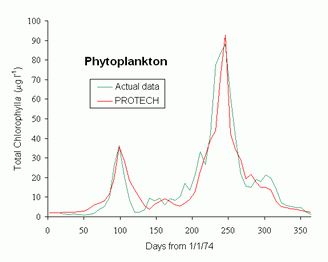Phytoplankton RespOnses To Environmental CHange (PROTECH) model
The PROTECH model (Phytoplankton RespOnses To Environmental CHange) has been developed to simulate the in situ dynamics of phytoplankton in lakes and reservoirs, specialising in predicting phytoplankton species, particularly Cyanobacteria (blue-green algae).

We use species-specific growth-rates that respond to temperature, light and nutrients, and add specific movement characteristics. By building up from these traits, the best predictions can be made. Our algal library now holds more than 100 species types.
PROTECH is an expert system model that has been used for research (e.g. climate change impacts, nutrient pollution sensitivity) and commissioned projects (e.g. for the Environment Agency, water companies and Natural England). It has been applied to different water bodies around the world and has been used in more than 30 peer reviewed studies (Elliott et al., 2010).
- Contact Dr Alex Elliott for a copy of the latest PROTECH review paper or if you are interested in commissioning the application of PROTECH.
Reynolds-Maberly model
Expanding on the Vollenweider approach, C S Reynolds and S C Maberly presented in Freshwater Biology (Volume 47, Issue 6, June 2002, 1183-1188) a method for calculating and comparing the stoichiometric yields of phytoplankton standing crop (as chlorophyll a).
In the article, some examples show how the model distinguishes lakes in which the supportive capacity is constrained mainly by the available phosphorus, or by the nitrogen supply or by the light availability. Sites are identified where control moves among the constraining factors.
Also, an instance of lake management is given, where the diagnosis, remedy and the remediation have conformed closely to the model predictions.
- The model requires MS Excel. Please fill in our short form to download:
